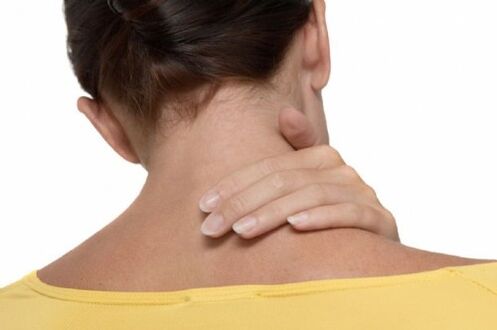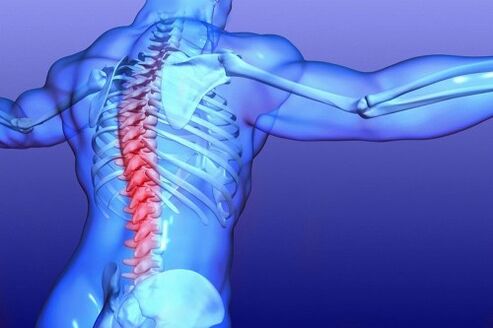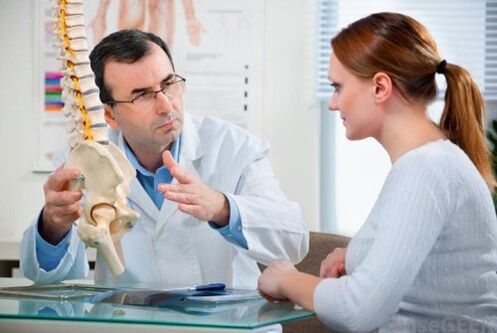Osteochondrosis forces the body to keep the muscles in the lumbar region tense, reducing the load on the spine. The patient looks for a more comfortable position and tries not to change it to reduce discomfort.

The main step
The disease is progressive, therefore, at different stages it has corresponding signs, the diagnosis of which helps the doctor to prescribe the correct treatment. Symptoms of lumbar osteochondrosis:
- in the first stage, there is clear discomfort and unobtrusive pain in the lumbar spine;
- the second stage is accompanied by the destruction of the annulus fibrosus, which leads to the convergence of the vertebrae among themselves;
- this is followed by the formation of an intervertebral hernia and a significant deformation of the spine, accompanied by severe pain;
- the fourth stage of osteochondrosis of the lumbar region leads to the complete disability of the patient: the destruction becomes more intense, preceded by sharp pain and difficulty in movement.
At any stage, the picture of the development and further treatment of osteochondrosis depends on the localization of the disease in a certain part of the lower back. This therapy aims to relieve pain, eliminate inflammation, normalize the metabolic process of the cartilage tissue of the spinal disc.
Osteochondrosis of the lumbar region is a dangerous degenerative disease of the spine, which leads to a degenerative process. It is localized in the corresponding area and is characterized by ossification of cartilage or destruction of the ridge disc. More than 80% of the course is accompanied by pain radiating to the leg. Symptoms of pain caused by pinching the root of the spinal nerve by too large tissue, in medicine they are called lumboischialgia.

Early signs
Symptoms of lumbar osteochondrosis are accompanied by dull pain, which, as a rule, goes unnoticed. Unpleasant sensations appear in the back or buttocks after transferring weight and sudden movements. The early degradation process of the lumbar intervertebral region begins.
The vertebral ridge functions without any special changes, but the morphological process of shriveled cartilage tissue continues to develop, accompanied by the following signs:
- an increase in the uncinate process;
- minimal disc displacement with fibrous capsule rupture.
Clinical symptoms - shooting pain after physical exercise and prolonged (frequent) sitting in an uncomfortable position.
Sometimes the first stage is called preclinical, because lumbar osteochondrosis may be practically undetectable.
Second stage
Symptoms of this stage are chronic pain that radiates to the pelvic organs, back or legs. Both relapse and remission are characteristic. Basically, deterioration is observed after physical exertion.
Third stage
The progressive process leads to the formation of a hernia with all the following consequences:
- neurological symptoms (dizziness, headache, fainting, tinnitus and loss of consciousness);
- problems with the kidneys and genitourinary system (uncontrollable urination);
- problems with the cardiovascular system (arrhythmias).
In the third stage, treatment, in addition to medication and physiotherapy methods, may include surgery to prevent compression of the spinal cord and the development of unwanted complications.
Fourth stage
The final stage is accompanied by calcification of the damaged disc. The pain became weaker, but the deformation of the spine continued. The body, activating the defense mechanism, begins the process of ossification, which leads to a decrease in the epidural space, increased compression of the spinal cord and disruption of the work of all systems controlled by it. In short, cartilage turns into bone and grows. From here, many dangerous symptoms appear, characteristic of the third stage, but in a more acute form.
Prolonged complex treatment and surgical intervention are required.

How to distinguish where the lesion is localized
Pinching certain nerve ends and segments has its own manifestations and symptoms of osteochondrosis:
- with damage to the spinal roots L1, L2 - severe pain, numbness of the inguinal zone and inner thigh. The development of osteochondrosis of the lower back, accompanied by a hernia, is characterized by lumboischialgia in both lower parts;
- when localized in the L5 lumbar region, shooting pain is characteristic with irradiation to the thumb, decreased sensitivity;
- with numbness in the outer thigh down to the leg and shooting pain, the problem is pinching the root of the S1 nerve.
Treatment is prescribed after diagnosis by MRI.
Symptoms of osteochondrosis of the lumbosacral region
The localization of the disease has a direct effect on its course and symptoms. Degeneration of the lumbar spine can cause myelogenous lameness. The lower spinal cord receives a limited blood supply, which causes weakness in the legs when walking and a frequent urge to urinate. After proper rest, the symptoms disappear.
Cauda equina neuron ischemia is the main cause of caudogenic intermittent claudication:
- anemia of the peripheral part of the legs;
- tingling and tingling when walking;
- in time the symptoms increase from the legs to the inguinal region of the genitals;
- strength in the legs is restored after rest.
Lifting heavy objects in the presence of lumbar osteochondrosis can cause pinching of the Adamkevich artery and complicate the course of spinal disease. There is paralysis - from mild to severe, incontinence of waste products, atrophy of muscle tissue, formation of bedsores.

Reasons that contribute to the development of osteochondrosis
In most cases, it is believed that the development of osteochondrosis gradually develops due to bipedalism, but additional provocative factors play an important role in the formation of spinal diseases, which include: physical inactivity, impaired metabolic processes, excess weight, lifting weights. .
A complex interaction of adverse factors, the formation of prolapse (disc protrusion) leads to narrowing of the epidural space and pinching of the nerve root.
Medical methods to deal with this disease
Treatment of lumbar osteochondrosis at different stages is carried out after accurate diagnosis of the location, stage and individual characteristics of the patient. The main methods are physiotherapy, reflex effects, drug support aimed at reducing pain and stopping inflammation, herbal medicine. If treatment turns out to be ineffective or impossible without surgery due to neglect of the disease, surgical intervention is required.



















